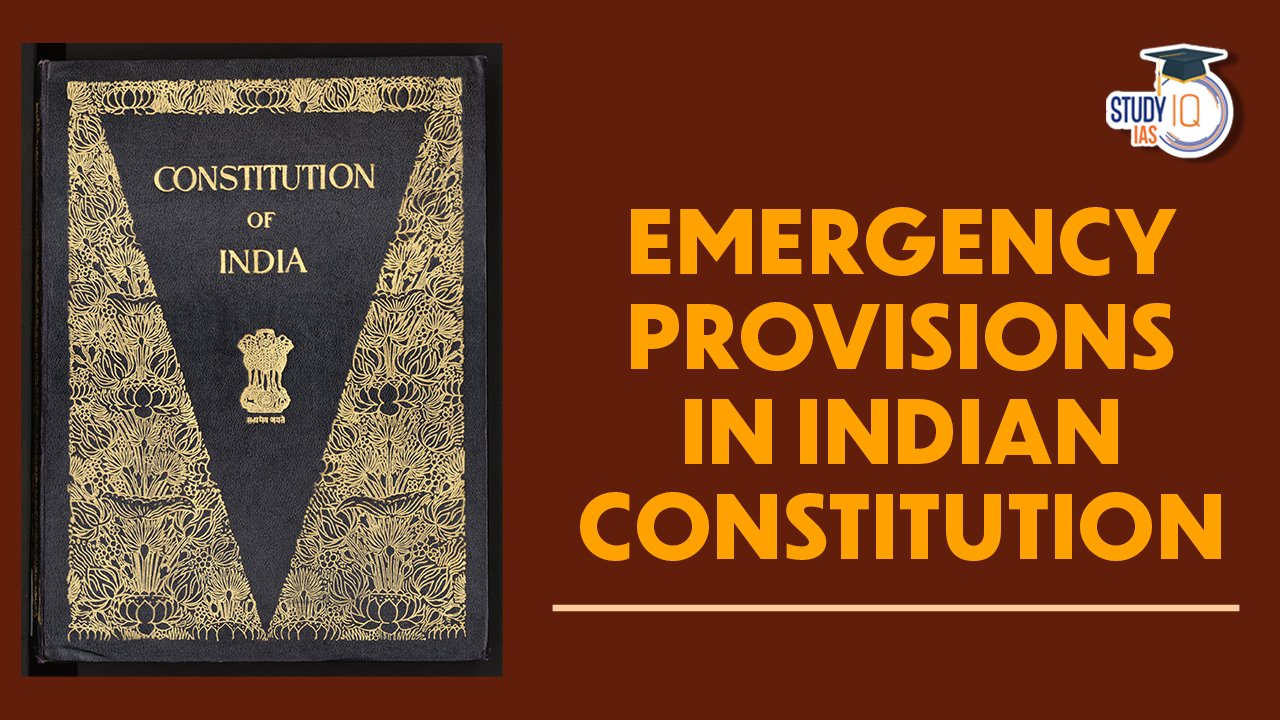Table of Contents
Context: 50 years ago, on June 25, 1975, a national emergency was declared in India.
Emergency Provisions in Indian Constitution
The Government of India Act 1935 served as the inspiration for the emergency provision in the Indian Constitution. Articles 352 through 360 of Part 18 of the Indian Constitution discuss emergency measures and deal with emergencies in India. A state of emergency transfers all authority to the central government.
- Enumerated in Part XVIII of the Constitution. It mentions 3 types of Emergencies;
- National Emergency – Article 352
- State Emergency (popularly known as President Rule) – Article 356
- Financial Emergency – Article 360.
Emergency Provisions in Indian Constitution: History
- The Constitution’s founders faced challenges like casteism and communalism, leading to the creation of Article 352 to prevent separatism during tensions with Pakistan and resistance from regions like Hyderabad and Junagarh.
- After independence, the rise of socialist governments and communist movements, especially in Telangana, prompted the introduction of Article 356 to protect legislative processes during serious emergencies.
- Dr. B.R. Ambedkar later added Article 360 to address the country’s declining financial situation and foreign currency reserves.
Part 18 of Indian Constitution: Emergency Provisions
Under Part 18 of the Constitution, where particular articles have been drafted, the emergency provisions of the Indian Constitution are mentioned. An essential supplement that discusses the many emergency scenarios that can arise in India is the emergency article.
- Article 352 was added to the constitution to address emergencies brought on by external threats like war or armed insurrection.
- Article 356 addressed the President’s declaration of an emergency as a result of the broken constitutional mechanism.
- Article 360 – Because the nation’s financial stability was in jeopardy, this article was added to deal with the Financial Emergency. Dr. B.R. Ambedkar added it considerably later.
| Did You Know |
|
Types of Emergency
The purpose of the emergency provisions is to ensure that the country is prepared for emergencies and that the necessary actions may be performed should they arise. These emergency clauses in the Indian Constitution were included in an effort to safeguard the nation’s integrity, sovereignty, and general security as well as to provide the necessary framework for the President to declare a national emergency. Three sorts of emergencies have been identified based on the three articles that were created to address emergencies, as shown below:
- National Emergency
- Constitutional Emergency/State Emergency
- Financial Emergency
National Emergency
A national emergency can be declared when there is war, outside attacks, or serious rebellion. The Constitution uses the term “proclamation of emergency” for this.
Reasons for Declaration
- According to Article 352, the president can declare a national emergency if India’s security is threatened by war, outside attacks, or rebellion.
- The president can declare this even before an actual war or attack happens.
- If the emergency is due to war or outside attacks, it’s called an External Emergency. If it’s due to rebellion, it’s called an Internal Emergency.
- The term “armed rebellion” was added later; before that, it was referred to as an internal disturbance.
Example:
- If India and Pakistan openly say they will fight, that’s war.
- If there’s no formal announcement but one country threatens another, that’s external aggression.
- An emergency can be declared based on these situations.
Important Facts
- In 1975, the 38th Amendment Act made national emergency declarations unchallengeable in court, but this was removed in 1978.
- The Supreme Court ruled in 1980 that an emergency can be challenged if it’s based on bad reasons or irrelevant facts.
Parliamentary Approval and Duration
- Congress must approve the emergency declaration within one month.
- If the Lok Sabha (the lower house) is dissolved during this time, the emergency remains until 30 days after the Lok Sabha is reformed, as long as the Rajya Sabha (the upper house) has approved it.
- If both houses approve, the emergency lasts for six months and can be extended every six months with parliamentary approval.
- Each approval must pass with a special majority.
Ending the Emergency
- The president can revoke the emergency at any time without needing parliamentary approval.
- If the Lok Sabha votes to disapprove it, the emergency must end.
- Effects of National Emergency
Centre-State Relations
- The central government can direct states on any issue.
- Parliament can make laws on state matters, and the president can issue temporary laws if Parliament isn’t in session.
- The president can change how money is shared between the centre and the states.
Lok Sabha and State Assembly:
- The Lok Sabha can be extended beyond its usual term for a year at a time, but not more than six months after the emergency ends.
- State assemblies can also be extended similarly.
Fundamental Rights
- Article 19 rights are automatically suspended during an emergency, but will return after it ends.
- The 44th Amendment stated that Article 19 can only be suspended during emergencies due to war or outside aggression, not rebellion.
- Under Article 359, the president can suspend the right to approach courts for enforcing fundamental rights during an emergency, but this must be approved by Parliament.
- The president cannot suspend rights related to Articles 20 and 21.
National Emergencies have been declared Three times:
| Past declaration |
|
Constitutional Emergency or President’s Rule
Article 355 requires the central government to ensure that each state is run according to the Constitution. If a state fails to do this, the central government can take over under Article 356, which is known as the President’s Rule.
Reasons for President’s Rule
- The President can declare President’s Rule if he believes the state government can’t function according to the Constitution.
- Under Article 365, if a state doesn’t follow central directives, the President can also declare that the state government is not functioning properly.
Parliamentary Approval and Duration
- Both Houses of Parliament must approve the proclamation of President’s Rule within 2 months of its issue
- Required majority: Simple majority.
- Duration of the President Rule: If approved by both houses, the President’s rule continues for 6 months.
Consequences of President’s Rule
- The President can assume the functions of the state government and any powers held by the governor.
- The President can also decide that Parliament will take over the state legislature’s powers.
- Other necessary actions can be taken, including suspending certain constitutional provisions in the state.
Judicial Review
The 38th Amendment (1975) made the President’s decision in these cases unchallengeable in court, but this was changed by the 44th Amendment (1978), allowing judicial review of the President’s actions.
Effects of President Rule
- The President is empowered to administer the state under the President’s rule, as it dismisses the State Council of ministers headed by the Chief Minister.
- The President can declare that the powers of the state legislature are to be exercised by the Parliament.
- The President can take all other important steps, including the suspension of the constitutional provisions relating to any authority in the state, except provisions related to the High Court.
Financial Emergency
Grounds for Declaration: Article 360 allows the President to declare a Financial Emergency if the financial stability or credit of India or any part of it is threatened.
Parliamentary Approval and Duration
- This declaration must be approved by both Houses of Parliament within two months.
- If the Lok Sabha is dissolved during this time, the declaration remains in effect until 30 days after the new Lok Sabha meets, as long as the Rajya Sabha has approved it.
- Once approved, a Financial Emergency can last indefinitely until revoked.
Effects of Financial Emergency
- The central government can take control of financial matters in the states.
- Salaries and allowances of state employees can be reduced.
- All financial bills passed by state legislatures must be sent to the President for approval.
- The President can also direct salary reductions for central employees and judges of the Supreme Court and High Courts.
44th Amendment of Indian Constitution
In 1978, a new law called the 44th Amendment was added to the Indian Constitution. This amendment changed some of the emergency rules that had been altered by the earlier 42nd Amendment, which was seen as going against the people’s wishes. The 44th Amendment aimed to fix those changes and adjust them to better serve the country’s interests.
The Act initially stipulates that any alterations to the fundamental structure of the constitution may only be made with the consent of the populace, which may be determined by a majority vote. Article 368 amendments could be used to achieve this. Students can read all the details related to UPSC by visiting the official website of StudyIQ UPSC Online Coaching.


 SLAPP Suits: Meaning, Examples, Impact o...
SLAPP Suits: Meaning, Examples, Impact o...
 Finance Commission of India, Articles an...
Finance Commission of India, Articles an...
 High Number of Pending Cases in Supreme ...
High Number of Pending Cases in Supreme ...

























